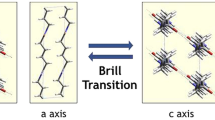Abstract
The molecular structure of room temperature (RT) nylon 66 and its transition to the high temperature (HT) form have been examined by X-ray crystallographic techniques. An initial literature survey on the RT form revealed a number of anomalies in the spatial relationships of the molecules within the unit cell, namely, poor ethylenic segment packing, distortion of the amide group from a planar configuration and lack of similarity on the projected cell base between RT nylon 66 and RT nylon 6. These anomalies have been resolved, and models proposed which give a better fit between calculated and observed data. The remainder of the paper describes the examination of the HT form with the object of determining whether or not a three-dimensional hydrogen bonded network could exist beyond 180° C. By determining unit cell dimensions and measuring intermolecular hydrogen bond distances it was possible to eliminate certain directions for hydrogen bonded planes. On the basis that any such distance must not exceed about 0.31 nm, which is the maximum hydrogen bond distance reported in the literature, it was concluded that a three-dimensional network could not exist. The cause of the structural transition is attributed to progressive changes in ethylenic segment torsion angles.
Similar content being viewed by others
References
C. W. Bunn andE. V. Garner,Proc. Roy. Soc. A 189 (1947) 39.
R. Brill,J. Prakt. Chem. 161 (1943) 49.
G. F. Schmidt andH. A. Stuart,Z. Naturforsch. 13a (1958) 222.
W. P. Slitcher,J. Polymer Sci. 35 (1958) 77.
C. G. Cannon, F. P. Chappel andJ. I. Tidmarsh,J. Text. Inst. 54 (1963) T210-T221.
J. D. Bernal,Proc. Roy. Soc. A 113 (1926) 117.
I. Pauling andR. B. Corey,Fortschr. Chem. Org. Natstoffe. 11 (1954) 180.
M. G. Northolt andL. E. Alexander,J. Phys. Chem. 72 (1968) 2838.
M. G. Northolt andL. E. Alexander,Acta Cryst. B 27 (1971) 523.
D. R. Holmes, C. W. Bunn andD. J. Smith,J. Polymer Sci. 17 (1955) 159.
V. Vand andI. P. Bell,Acta Cryst. 4 (1951) 465.
A. Keller andA. Marradudin,J. Phys. Chem. Solids. 2 (1957) 301.
C. G. Cannon,Spectrochim. Acta 16 (1960) 302.
H. G. Olf andA. Peterlin,J. Polymer Sci. A 2 9 (1971) 1449.
D. S. Trifan andI. F. Terenzi,J. Polymer. Sci. 28 (1958) 443.
E. Bessler andG. Bier,Makromol. Chem. 28 (1969) 443.
W. P. Slitcher,J. Polymer Sci. 35 (1959) 77.
Author information
Authors and Affiliations
Rights and permissions
About this article
Cite this article
Colclough, M.L., Baker, R. Polymorphism in nylon 66. J Mater Sci 13, 2531–2540 (1978). https://doi.org/10.1007/BF02402738
Received:
Accepted:
Issue Date:
DOI: https://doi.org/10.1007/BF02402738




